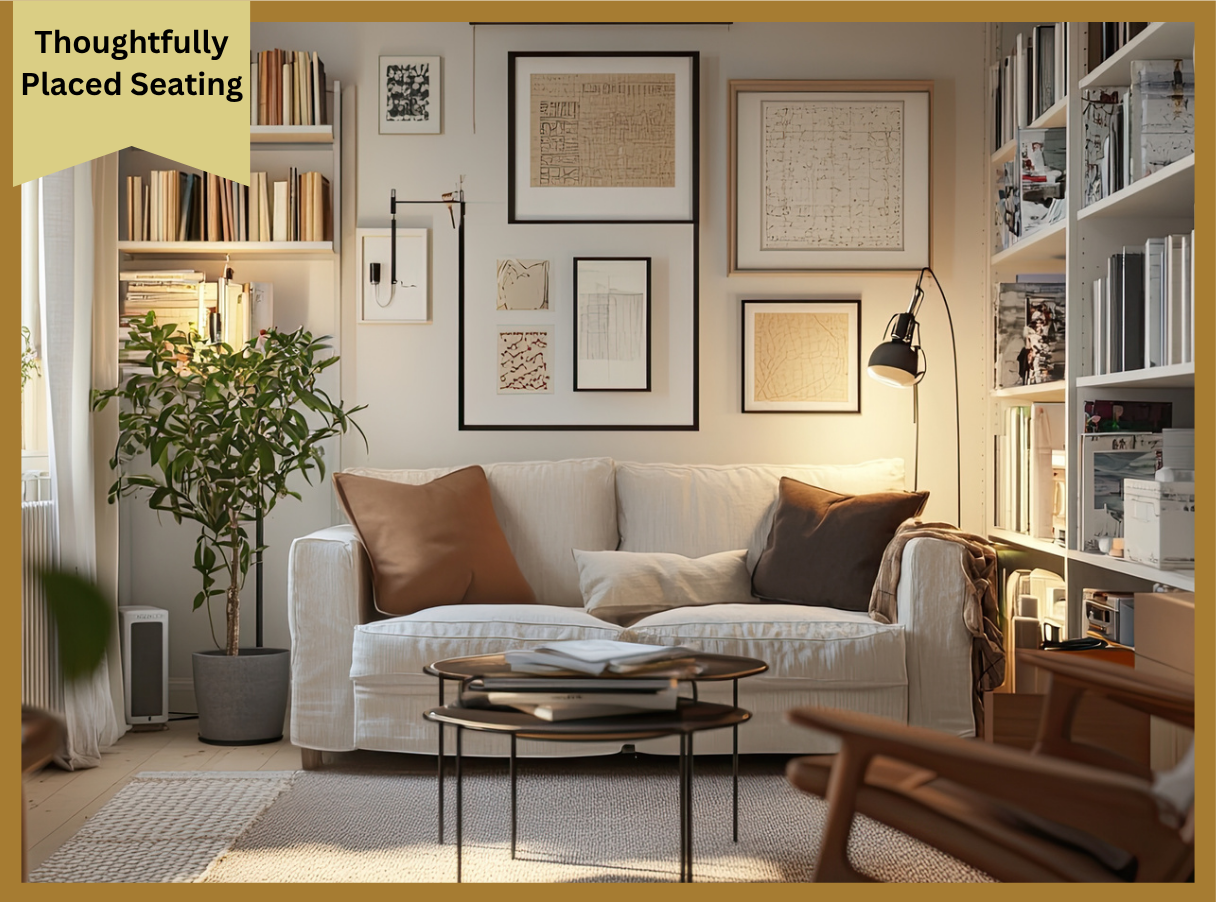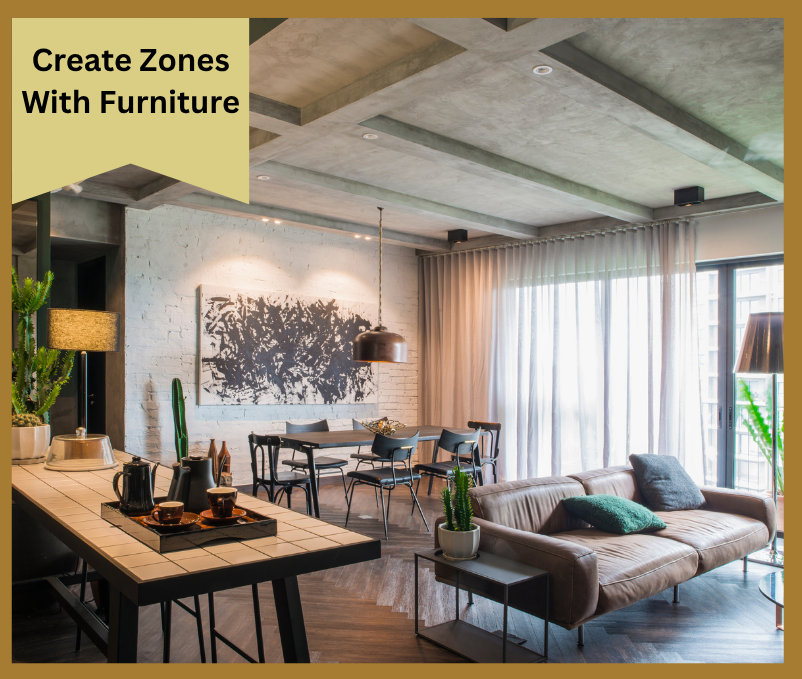Furniture That Fits: Why Placement Matters
Is your furniture helping, or hurting,
your space?
Even the most stunning furniture can fall flat if it is not thoughtfully placed. The truth is, great design is not just about what you bring into a room, it is also about how you arrange it. Whether you are redecorating a single space or furnishing an entire home, the placement of your pieces shapes how the room feels, functions, and flows.
Before you buy another piece, have you planned where it will live?
Several years ago, I was working with a long-time client who had reached the accessorizing stage of his home project. We had already completed the major furnishings, and now we were focusing on those final, meaningful touches, pieces with personality, items that told a story. He invited me to one of his favorite antique shops, a place he loved to browse for eclectic treasures.
As we wandered through the aisles, full of vintage finds and nostalgic curiosities, his eyes landed on a beautiful rolltop desk. It was large and substantial, a true conversation piece. The wood had not been refinished, but it was in pristine condition, well-loved and clearly cared for. His whole face lit up. “I want to buy it,” he said, already turning to make an offer.
But I gently held up my hand. “Wait,” I said. “I know you love it, it is a beautiful piece. But where is it going to live? Can you picture where it would go in your home, and what you would use it for?”
This client had recently retired, and part of the reason we were redesigning his home was because he no longer needed a formal office. In fact, he was intentionally stepping away from that chapter of his life. As we revisited each room in his mind, it became clear that there was no natural home for such a large desk, not anymore.
We paused together in that moment, and I watched him come to a quiet realization. “You’re right,” he said. “There was a time when I would’ve made space for something like this, maybe even rearranged a whole room to make it fit. But I’m not in that season anymore.”
It was a powerful reminder: just because a piece is beautiful, meaningful, or nostalgic does not mean it belongs in your home today. There has to be a purpose. A place. A role it plays in supporting your life right now.
Start with Purpose, Not Style
When I meet with a client who is ready to invest in new furniture, we do not begin with Pinterest boards or fabric swatches. Not yet. We start by asking questions.
I need to understand what the client envisions for the room. Who is going to use this space? What is its primary function? Is it a place for lively entertaining or quiet retreat? Is it intended for conversation, relaxation, work, or family time? Most importantly, how many people will be using the room, and how do they need it to serve them?
Furniture is not just about what is trending or visually appealing, it has to be functional. It has to support the people who live in the home.
These foundational questions shape every decision that follows. They determine the types of pieces we bring in, the durability and cleanability of the fabrics, and whether we need to accommodate pets, children, or aging adults. Do we need motion seating for comfort or accessibility? Should we consider convertible furniture for guests or multifunctional rooms? Is this a public space or a private one? Will it include a television or serve multiple purposes throughout the day?
I could go on and on, because these questions matter. Yet what I see most often is a lack of imagination or awareness around how furniture really works. People tend to default to what they have always known, lining pieces up against the wall, creating rigid traffic paths, and missing the opportunity to make their home work harder and smarter for their lifestyle.
True design begins with intention, not aesthetics. Before we talk about what looks good, we have to talk about what works well.
Furniture Placement with Intention
Furniture placement is the heartbeat of a well-designed room. It shapes how you live, move, and connect within the space. You can have all the right pieces, but if they are not placed with purpose, the room may feel off, disconnected, awkward, or even uncomfortable. But when furniture is arranged with care and creativity, the result is a room that feels harmonious, responsive, and truly welcoming.
A thoughtfully placed seating arrangement does more than fill space, it invites people in. It encourages conversation, creates comfort, and supports the function of the room. Chairs spaced too far apart can feel cold and impersonal. Sofas pushed against the walls often mimic a waiting room rather than a space meant for gathering. But when pieces are pulled together, an accent rug is brought in to ground them, a cocktail table to anchor the center, and a clear walkways is created to move around them, you begin to foster warmth and flow.
There is no one “right” way to place furniture. A conversation area might include a pair of swivel glider chairs flanking a small table. Or perhaps two facing sofas with a cocktail table in between for hosting guests. Some families prefer electric recliners for comfort, arranged with a sleek sofa and accented with side tables and reading lamps. Each grouping should reflect the needs, taste, and lifestyle of the people using the space.
I often like to mix mediums to bring depth and texture to a room. A rustic wood side table next to a metal or glass cocktail table, or an unexpected statement floor lamp that doubles as a conversation starter. A room feels far more personal, and far less staged, when its furniture tells a story. This is especially true when incorporating heirloom pieces or items with sentimental value. Blending these into a modern arrangement adds character and reflects the homeowner’s unique personality.
And while the television is often a feature of the room, I rarely treat it as the main event, unless the room’s specific purpose calls for it. In many cases, the television can be a supporting element, tucked to the side or blended seamlessly into a wall design, allowing the seating to prioritize connection instead.
This approach applies beyond the living room, too. Dining areas deserve the same intentionality. Just because a table seats eight does not mean all eight chairs need to remain around it at all times. Tucking a few chairs along the wall can open up the room visually and offer a more elegant display opportunity for a floral arrangement or seasonal centerpiece. Pair that with a well-placed, personality-filled light fixture overhead, and the entire room takes on new life.
Furniture placement is not about rules, it is about responsiveness. It is about arranging a space that meets your needs, supports your lifestyle, and expresses your sense of home. When done with intention, the result is not just beautiful, it is deeply livable.
Make Every Zone Work Harder
In open-concept homes, furniture placement becomes your architecture, it defines zones where no walls exist. But even in smaller or more traditional layouts, the same principle applies. From kitchens to bedrooms, entryways to offices, every room benefits from thoughtful layout. A comfy bench in the mudroom. A reading nook in the primary suite. A clear path to the coffee maker in the morning. These details may seem small, but they are the difference between a room that is lived in, and one that is truly loved.
Furniture is not always just about form or function. It should also be about feeling. Your rooms should feel like they fit you, your rhythm, your routines, and your relationships. When furniture is placed with care, your entire home becomes a space that welcomes, supports, and reflects the way you truly live.
Tina Wright launched The Design Journal in 2024 as a space to share expert insights, timeless design principles, and practical tips for creating beautiful functional homes. In 2025 she expanded her reach by writing, a monthly local newspaper column, offering readers a deeper dive into the art of interior design. As the owner and principal designer of Fine Interiors of WNC, Tina brings over 25 years of experience to her work, transforming homes across the Southeastern U.S. with her client-focused approach and passion for design. Whether through her newspaper column, blog, or one-on-one consultation, she is dedicated to helping homeowners make timeless, thoughtful, design choices.



We Would Love to Hear From You!
Have you ever faced a design challenge in your home, big or small, and found a creative solution that worked for you?
Whether it was a clever layout tweak, a bold color choice, or a DIY fix that made all the difference, your experience might inspire someone else.
Feel free to share with me, send photos to Tina at fineinteriors@msn.com. I always enjoy hearing from readers and clients, it’s how the best design conversations begin.
Frequently Asked Questions:
FAQ: How do I know if my furniture is arranged correctly?
Answer: A well-arranged room should feel intuitive, comfortable, and easy to navigate. You should be able to move around without bumping into furniture, and conversations should feel natural, no one should be shouting across the room or turning awkwardly. If something feels “off,” it often comes down to scale, spacing, or purpose. That is why I always start with how the room is actually lived in before anything else.
FAQ: Does all my furniture have to match?
Answer: Not at all. In fact, I often encourage clients to mix materials and styles to add interest and depth. A blend of wood, metal, and upholstery can bring personality to a space, especially when done with intention. Matching everything can feel flat or overly staged, your home should look curated, not cookie-cutter.
FAQ: Should my furniture always be pushed up against the walls?
Answer: No. In most rooms, pulling furniture off the walls actually creates a more inviting and balanced layout. Floating pieces within the room, anchored by a rug and arranged for conversation, often results in better flow and functionality. Wall-lined furniture is usually a default, not a design choice.
FAQ: How do I choose the right furniture size for my space?
Answer: Start with the room’s dimensions and the way you plan to use the space. Oversized furniture in a small room can feel cramped, while undersized furniture in a large room can seem lost. I look at traffic patterns, focal points, and how many people need to use the space. Then I help clients select pieces that are both proportional and practical.
FAQ: What if I have heirloom or existing pieces I want to keep?
Answer: Great! I love incorporating meaningful pieces into a design. Whether it is a vintage armchair, a family dining table, or a unique lamp, these elements add soul to the space. The key is balancing them with complementary furniture and arranging everything in a way that still feels intentional and cohesive.




